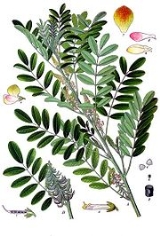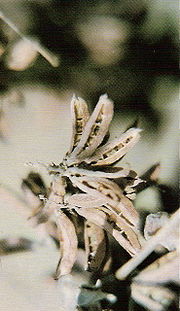
Añil
Encyclopedia
Indigofera suffruticosa, commonly known as Anil, Guatemalan indigo, Small-leaved indigo (Sierra Leone), West Indian indigo, and Wild indigo, is a flowering plant
in the pea
family, Fabaceae
. In Hawaiian
it is known as either Inikō/Inikoa, or Kolū; in Fijian
it is called Vaivai, the Samoans
call it Laau mageso, on Guam
it is called Aniles, and in Tonga
it is referred to as akauveli (itchy plant).
Añil is native to the subtropical
and tropical
Americas
, including the southern United States
, the Caribbean
, Mexico
, Central America
, and South America
as far south as Northern Argentina
. This species has been widely introduced
to other parts of the world and today has a pantropical
distribution. It is an erect branching shrub
growing to 1 m (3.3 ft) tall with pinnate
leaves
, and is commonly found growing in dry, highly disturbed areas
such as roadsides and fallow fields.

 Añil is commonly used as a source for indigo dye
Añil is commonly used as a source for indigo dye
and if mixed with certain clay
s can produce Maya Blue
or Azul Maya, a pigment
used by the Mesoamerica
n civilizations.
Flowering plant
The flowering plants , also known as Angiospermae or Magnoliophyta, are the most diverse group of land plants. Angiosperms are seed-producing plants like the gymnosperms and can be distinguished from the gymnosperms by a series of synapomorphies...
in the pea
Pea
A pea is most commonly the small spherical seed or the seed-pod of the pod fruit Pisum sativum. Each pod contains several peas. Peapods are botanically a fruit, since they contain seeds developed from the ovary of a flower. However, peas are considered to be a vegetable in cooking...
family, Fabaceae
Fabaceae
The Fabaceae or Leguminosae, commonly known as the legume, pea, or bean family, is a large and economically important family of flowering plants. The group is the third largest land plant family, behind only the Orchidaceae and Asteraceae, with 730 genera and over 19,400 species...
. In Hawaiian
Hawaiian language
The Hawaiian language is a Polynesian language that takes its name from Hawaii, the largest island in the tropical North Pacific archipelago where it developed. Hawaiian, along with English, is an official language of the state of Hawaii...
it is known as either Inikō/Inikoa, or Kolū; in Fijian
Fijian language
Fijian is an Austronesian language of the Malayo-Polynesian family spoken in Fiji. It has 450,000 first-language speakers, which is less than half the population of Fiji, but another 200,000 speak it as a second language...
it is called Vaivai, the Samoans
Samoan language
Samoan Samoan Samoan (Gagana Sāmoa, is the language of the Samoan Islands, comprising the independent country of Samoa and the United States territory of American Samoa. It is an official language—alongside English—in both jurisdictions. Samoan, a Polynesian language, is the first language for most...
call it Laau mageso, on Guam
Guam
Guam is an organized, unincorporated territory of the United States located in the western Pacific Ocean. It is one of five U.S. territories with an established civilian government. Guam is listed as one of 16 Non-Self-Governing Territories by the Special Committee on Decolonization of the United...
it is called Aniles, and in Tonga
Tongan language
Tongan is an Austronesian language spoken in Tonga. It has around 200,000 speakers and is a national language of Tonga. It is a VSO language.-Related languages:...
it is referred to as akauveli (itchy plant).
Añil is native to the subtropical
Subtropics
The subtropics are the geographical and climatical zone of the Earth immediately north and south of the tropical zone, which is bounded by the Tropic of Cancer and the Tropic of Capricorn, at latitudes 23.5°N and 23.5°S...
and tropical
Tropics
The tropics is a region of the Earth surrounding the Equator. It is limited in latitude by the Tropic of Cancer in the northern hemisphere at approximately N and the Tropic of Capricorn in the southern hemisphere at S; these latitudes correspond to the axial tilt of the Earth...
Americas
Americas
The Americas, or America , are lands in the Western hemisphere, also known as the New World. In English, the plural form the Americas is often used to refer to the landmasses of North America and South America with their associated islands and regions, while the singular form America is primarily...
, including the southern United States
Southern United States
The Southern United States—commonly referred to as the American South, Dixie, or simply the South—constitutes a large distinctive area in the southeastern and south-central United States...
, the Caribbean
Caribbean
The Caribbean is a crescent-shaped group of islands more than 2,000 miles long separating the Gulf of Mexico and the Caribbean Sea, to the west and south, from the Atlantic Ocean, to the east and north...
, Mexico
Mexico
The United Mexican States , commonly known as Mexico , is a federal constitutional republic in North America. It is bordered on the north by the United States; on the south and west by the Pacific Ocean; on the southeast by Guatemala, Belize, and the Caribbean Sea; and on the east by the Gulf of...
, Central America
Central America
Central America is the central geographic region of the Americas. It is the southernmost, isthmian portion of the North American continent, which connects with South America on the southeast. When considered part of the unified continental model, it is considered a subcontinent...
, and South America
South America
South America is a continent situated in the Western Hemisphere, mostly in the Southern Hemisphere, with a relatively small portion in the Northern Hemisphere. The continent is also considered a subcontinent of the Americas. It is bordered on the west by the Pacific Ocean and on the north and east...
as far south as Northern Argentina
Argentina
Argentina , officially the Argentine Republic , is the second largest country in South America by land area, after Brazil. It is constituted as a federation of 23 provinces and an autonomous city, Buenos Aires...
. This species has been widely introduced
Introduced species
An introduced species — or neozoon, alien, exotic, non-indigenous, or non-native species, or simply an introduction, is a species living outside its indigenous or native distributional range, and has arrived in an ecosystem or plant community by human activity, either deliberate or accidental...
to other parts of the world and today has a pantropical
Pantropical
In biogeography, a pantropical distribution one which covers tropical regions of all of the major continents, i.e. in Africa, in Asia and in the Americas. Examples include the plant genera Acacia and Bacopa....
distribution. It is an erect branching shrub
Shrub
A shrub or bush is distinguished from a tree by its multiple stems and shorter height, usually under 5–6 m tall. A large number of plants may become either shrubs or trees, depending on the growing conditions they experience...
growing to 1 m (3.3 ft) tall with pinnate
Pinnate
Pinnate is a term used to describe feather-like or multi-divided features arising from both sides of a common axis in plant or animal structures, and comes from the Latin word pinna meaning "feather", "wing", or "fin". A similar term is pectinate, which refers to a comb-like arrangement of parts...
leaves
Leaf
A leaf is an organ of a vascular plant, as defined in botanical terms, and in particular in plant morphology. Foliage is a mass noun that refers to leaves as a feature of plants....
, and is commonly found growing in dry, highly disturbed areas
Ruderal species
A ruderal species is a plant species that is first to colonize disturbed lands. The disturbance may be natural , or due to human influence – constructional , or agricultural .Ruderal species typically dominate the disturbed area...
such as roadsides and fallow fields.


Indigo dye
Indigo dye is an organic compound with a distinctive blue color . Historically, indigo was a natural dye extracted from plants, and this process was important economically because blue dyes were once rare. Nearly all indigo dye produced today — several thousand tons each year — is synthetic...
and if mixed with certain clay
Clay
Clay is a general term including many combinations of one or more clay minerals with traces of metal oxides and organic matter. Geologic clay deposits are mostly composed of phyllosilicate minerals containing variable amounts of water trapped in the mineral structure.- Formation :Clay minerals...
s can produce Maya Blue
Maya Blue
Maya Blue is a unique bright azure blue pigment manufactured by cultures of pre-Columbian Mesoamerica, such as the Maya and Aztec.-Manufacture:...
or Azul Maya, a pigment
Pigment
A pigment is a material that changes the color of reflected or transmitted light as the result of wavelength-selective absorption. This physical process differs from fluorescence, phosphorescence, and other forms of luminescence, in which a material emits light.Many materials selectively absorb...
used by the Mesoamerica
Mesoamerica
Mesoamerica is a region and culture area in the Americas, extending approximately from central Mexico to Belize, Guatemala, El Salvador, Honduras, Nicaragua, and Costa Rica, within which a number of pre-Columbian societies flourished before the Spanish colonization of the Americas in the 15th and...
n civilizations.

